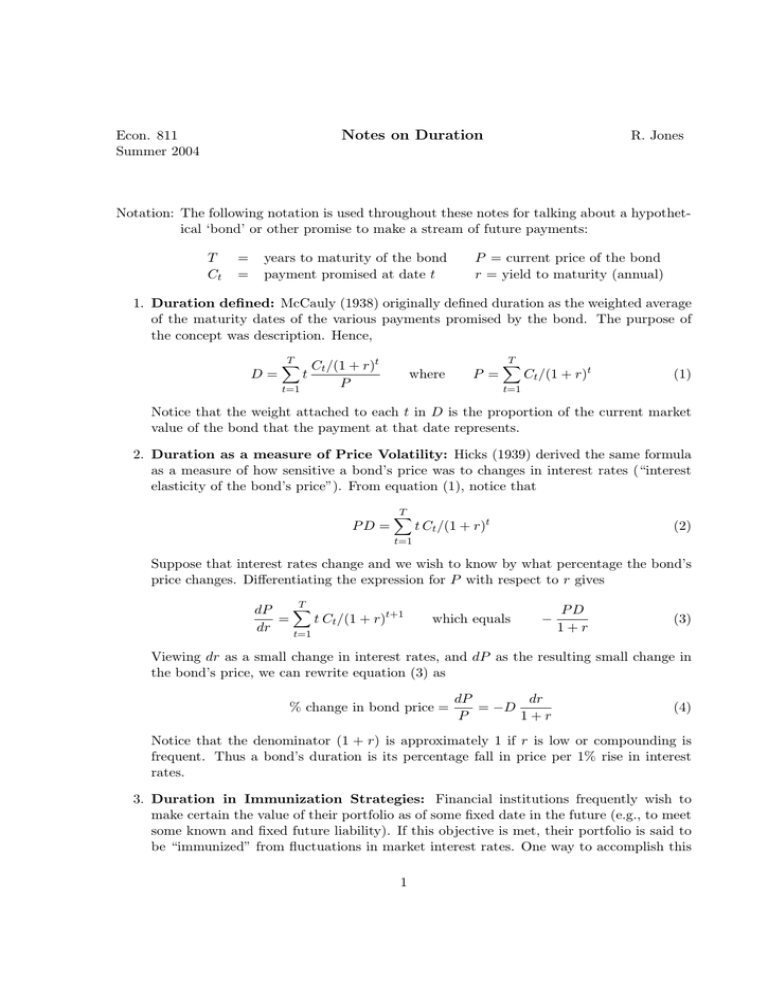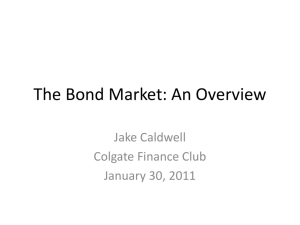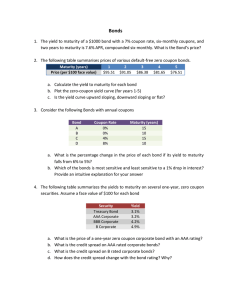Notes on Duration
advertisement

Notes on Duration Econ. 811 Summer 2004 R. Jones Notation: The following notation is used throughout these notes for talking about a hypothetical ‘bond’ or other promise to make a stream of future payments: T Ct = = years to maturity of the bond payment promised at date t P = current price of the bond r = yield to maturity (annual) 1. Duration defined: McCauly (1938) originally defined duration as the weighted average of the maturity dates of the various payments promised by the bond. The purpose of the concept was description. Hence, D= T X Ct /(1 + r)t t t=1 where P P = T X Ct /(1 + r)t (1) t=1 Notice that the weight attached to each t in D is the proportion of the current market value of the bond that the payment at that date represents. 2. Duration as a measure of Price Volatility: Hicks (1939) derived the same formula as a measure of how sensitive a bond’s price was to changes in interest rates (“interest elasticity of the bond’s price”). From equation (1), notice that PD = T X t Ct /(1 + r)t (2) t=1 Suppose that interest rates change and we wish to know by what percentage the bond’s price changes. Differentiating the expression for P with respect to r gives T X dP = t Ct /(1 + r)t+1 dr t=1 which equals − PD 1+r (3) Viewing dr as a small change in interest rates, and dP as the resulting small change in the bond’s price, we can rewrite equation (3) as % change in bond price = dP dr = −D P 1+r (4) Notice that the denominator (1 + r) is approximately 1 if r is low or compounding is frequent. Thus a bond’s duration is its percentage fall in price per 1% rise in interest rates. 3. Duration in Immunization Strategies: Financial institutions frequently wish to make certain the value of their portfolio as of some fixed date in the future (e.g., to meet some known and fixed future liability). If this objective is met, their portfolio is said to be “immunized” from fluctuations in market interest rates. One way to accomplish this 1 objective would be to purchase a pure discount or zero coupon bond maturing on the date of their future liability. But pure discount bonds of more than one year maturity are rare. With coupon bonds, there is uncertainty about the interest rate at which the coupon payments can be reinvested in the future. The concept of duration can be used to assist in constructing immunized portfolios of coupon bonds. We make the following assumptions for simplicity: H = intended holding period for the bond(s) W = final wealth as of time H resulting from the purchase of the portfolio Assumption (i): The yield curve is flat. Assumption (ii): The entire yield curve shifts when interest rates change. Suppose a single bond is purchased at its current price P . Since the yield curve is flat, its holding period yield over H years will be the same as its yield to maturity over T years, if no shifts in interest rates occur – both will equal r. Now suppose that a single once-and-for-all change in interest rates occurs just after the bond is purchased. What duration of bond should have been chosen to minimize the risk about the value of wealth as of time H? First, note that if no change in r occurs, then W = P (1 + r)H Taking the derivative of this expression (using the ‘chain rule’), we get dW dP dP = (1 + r)H + P H(1 + r)H−1 = ((1 + r) + P H)(1 + r)H−1 dr dr dr If we now substitute −P D/(1 + r) for dP/dr from equation (3), the expression for the change in terminal wealth per 1% shift in interest rates becomes dW = (H − D)P (1 + r)H−1 dr Thus if H = D (i.e., the duration of the bond is chosen to equal the intended holding period), then dW/dr = 0, meaning that final wealth has been immunized from risks of interest rate changes. The intuition behind this result is as follows: Each 1% rise in interest rates causes an approximately H% capital loss right away, since the duration of the bond was set equal to H; but you will earn a 1% higher yield on both the remaining capital value and all reinvested coupons over each of the H years remaining. These two amounts offset each other and you come out even as of the end of your holding period. Notice that since D is less than T , the time to maturity of a bond, you will end up holding a bond whose maturity date is later than when you intend to sell it. Also, since changes in interest rates will affect the D of your bond, and since as time passes your remaining holding period shrinks faster than the bond’s duration, you will have to periodically revise your bond holding to insure that D stays equal to H. 2 4. Duration of a Portfolio: The duration of a portfolio of bonds or similar assets is simply a weighted average of the durations of the individual assets in it, with each weighted by the proportion of the current value of the portfolio that it makes up. For example, if you held $5000 is a passbook savings account (0 duration), $5000 in 1 year Treasury Bills, and $10,000 in mortgages with a duration of 2 years, then the duration of your portfolio would be (1/4)0 + (1/4)1 + (1/2)2 = 1.25 years. 5. Formulas for Computing Duration: The definition of duration in (1) allows you to compute the duration of an arbitrary stream of fixed payments, but required the addition of a large number of terms if many payments are involved. Simpler formulas can be derived if you know that the ‘bond’ makes the same coupon payment every period, with a possibly larger final payment at maturity. Letting C r P = = = coupon payment/period yield to maturity current price Then D = V = additional payment at maturity (per period with compounding once per period) T = number of periods to maturity V /(1 + r)T C/r 1 + r C/r(1 + r)T 1+r T + ( ) − (T + ) P P r P r (5) To illustrate, if a $100 face value bond matured in 22 years, had a 10.25% coupon rate (paid once per year), and was currently selling for 69.25 to give a yield of 15.12% to maturity, then its duration would be 7.58 years. Try substituting the data into the formula to make sure that you know how to use it. Additional special cases, for which calculations are simpler, are: C = 0 (pure discount bonds): D = T = ∞ (consols): D = P = V (bond selling at par): D = V = 0 (fully amortized loan): D = T 1+r r 1+r 1 − r r(1 + r)T −1 T 1+r − r (1 + r)T − 1 Equation (4) can now be made a little more intuitive. A coupon bond can be thought of as a portfolio of bonds: a pure discount bond of face value V maturing in T years, plus a consol that pays C dollars each year forever, less (or short) a consol that pays C dollars forever but whose payments are deferred by T years. The right hand side of (4) is the weighted sum of the durations of these three types of bonds, with weights equalling the proportion of the total market value of the bond, P , that each bond type represents. Notice that the weights add up to 1, given that P must equal the present value of all the bond’s payments. 3 6. Factors Influencing Duration: The duration of a bond depends on its coupon rate, time to maturity and yield. We consider the effect of each in turn. A bond with 0 coupon rate is a pure discount bond, and its D equals T , its time to maturity. A rise in the coupon rate, holding constant its yield and T , decreases the bond’s duration since more and more of its present value is represented by the coupon payments. Figure 1 below graphs D against the coupon rate of 20 year bonds when interest rates are 15%. Thus high coupon rate bonds are ‘less risky’ than low coupon rate ones. A rise in the bond’s yield (the level of interest rates) also decreases its duration, since the later payments are discounted more heavily and hence are weighted progressively less heavily in the duration formula. At the extreme of infinite interest rates, the duration of the bond simply equals to time to the first coupon payment. Figure 2 graphs D against the level of interest rates for a 15% coupon rate 20 year bond. The falling duration as yields rise imply that a given bond’s price becomes less sensitive to changes in interest rates as they get higher. The effect of time to maturity on duration is somewhat unexpected. Starting from T = 0, duration initially rises one-for-one with T . For bonds selling at par or higher (i.e., with coupon rates at least equal to current interest rates), D continues to rise monotonically with T , approaching an upper limit equalling the duration of a consol with the same yield. But for bonds selling at a discount from par (i.e., with low coupon rates), D rises with T up to a point then actually declines towards this limiting value. Thus longer term bond prices can actually be less sensitive to interest rates than shorter term ones! Figure 3 is a graph of D versus T for 20% coupon rate bonds priced to yield 20% to maturity. Figure 4 is the same graph for 2% coupon rate bonds when interest rates are 20%. 4






